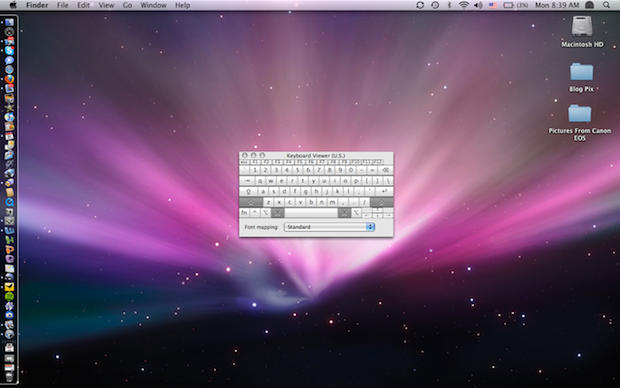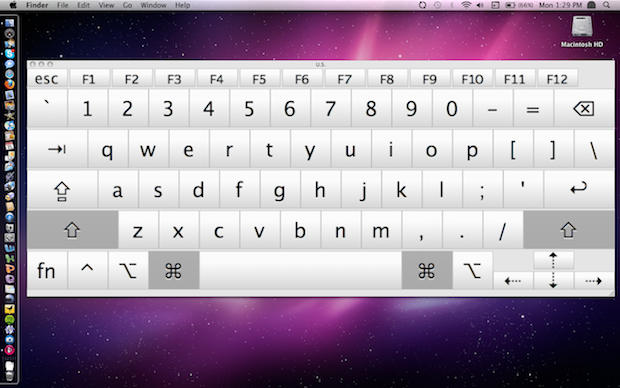The more I play with Snow Leopard, the more it looks like it’s designed to run Apple’s upcoming tablet.
Look at Expose in the Dock — the new feature that reveals all an application’s open windows when you click and hold the application’s icon. It’s tailor-made for fingers. Even more convincing is Stacks in the Dock. Hit a folder icon in the dock, and up pops the folder and all its files. Each icon is a big target for your finger, and the window has a big, fat slider for scrolling up and down (no more fiddly little arrows at the top or bottom). Both of these UI tweaks scream ‘touchscreen.’
And then today I discovered an unheralded feature that the minute I saw it, I thought, “Game over! Here’s rock-solid proof that Snow Leopard is designed for touchscreens. This is a tablet operating system.”
The new UI element s a virtual keyboard, a must-have for a tablet. Snow Leopard includes a big virtual keyboard that looks clearly designed for typing on a touchscreen. It’s a big, bold version of the iPhone’s virtual keyboard with large keys that scream “type me!”
The Mac OS has long contained a virtual keyboard, but previous versions were half-sized (see below). The old virtual keyboard was clearly not designed for actual typing, and was hidden away in the “International” tab of System Preferences. (Yeah, the keyboard could be enlarged by hitting the green button in the upper left of the folder toolbar, but still, it expanded to only three-quarter size).
The new virtual keyboard in Snow Leopard now lives under “Keyboard” in System Preferences, and is clearly put there as an alternative input method.
The virtual keyboard can be made as big as your screen — 30-inches wide, if you have a big Cinema Display — by dragging the window resizer at bottom left.
Of course, it can’t be used as a real virtual keyboard until Apple introduces a touchscreen device. At the moment, it just records the keystrokes on your physical keyboard and shows the characters that will be typed when the Option key is held down, and so on.
Yeah, I know, this isn’t proof that Snow Leopard is designed for a touchscreen device — IE. the tablet everyone knows Apple is working on — but I got pretty excited when I saw it. It looks like a key touchscreen UI element to me.
Here’s how to see it yourself:
* Go to System Preferences>Keyboard
* Click the box “Show Keyboard & Character Viewer in menu bar”
* Go to the menu bar at top right and click “Show Keyboard Viewer”
For comparison, here’s the old soft keyboard in Leopard. This is not a touchscreen keyboard.

Via 9to5Mac.

Leander Kahney is the editor and publisher of Cult of Mac.
Leander is a longtime technology reporter and the author of six acclaimed books about Apple, including two New York Times bestsellers: Jony Ive: The Genius Behind Apple’s Greatest Products and Inside Steve’s Brain, a biography of Steve Jobs.
He’s also written a top-selling biography of Apple CEO Tim Cook and authored Cult of Mac and Cult of iPod, which both won prestigious design awards. Most recently, he was co-author of Cult of Mac, 2nd Edition.
Leander has been reporting about Apple and technology for nearly 30 years.
Before founding Cult of Mac as an independent publication, Leander was news editor at Wired.com, where he was responsible for the day-to-day running of the Wired.com website. He headed up a team of six section editors, a dozen reporters and a large pool of freelancers. Together the team produced a daily digest of stories about the impact of science and technology, and won several awards, including several Webby Awards, 2X Knight-Batten Awards for Innovation in Journalism and the 2010 MIN (Magazine Industry Newsletter) award for best blog, among others.
Before being promoted to news editor, Leander was Wired.com’s senior reporter, primarily covering Apple. During that time, Leander published a ton of scoops, including the first in-depth report about the development of the iPod. Leander attended almost every keynote speech and special product launch presented by Steve Jobs, including the historic launches of the iPhone and iPad. He also reported from almost every Macworld Expo in the late ’90s and early ‘2000s, including, sadly, the last shows in Boston, San Francisco and Tokyo. His reporting for Wired.com formed the basis of the first Cult of Mac book, and subsequently this website.
Before joining Wired, Leander was a senior reporter at the legendary MacWeek, the storied and long-running weekly that documented Apple and its community in the 1980s and ’90s.
Leander has written for Wired magazine (including the Issue 16.04 cover story about Steve Jobs’ leadership at Apple, entitled Evil/Genius), Scientific American, The Guardian, The Observer, The San Francisco Chronicle and many other publications.
Leander has a postgrad diploma in artificial intelligence from the University of Aberdeen, and a BSc (Hons) in experimental psychology from the University of Sussex.
He has a diploma in journalism from the UK’s National Council for the Training of Journalists.
Leander lives in San Francisco, California, and is married with four children. He’s an avid biker and has ridden in many long-distance bike events, including California’s legendary Death Ride.
You can find out more about Leander on LinkedIn and Facebook. You can follow him on X at @lkahney or Instagram.




54 responses to “More Evidence That Snow Leopard Is a Touchscreen Operating System”
LOL – you know that window is resizable, right? By default, it tries to fill the screen – but you can resize to be the same (small) size as in Leopard.
And, as we’ve seen: Clues like this meant nothing about what OS would be used in the iPad.
And the ipad is running ios not os x
Heehee i just farted